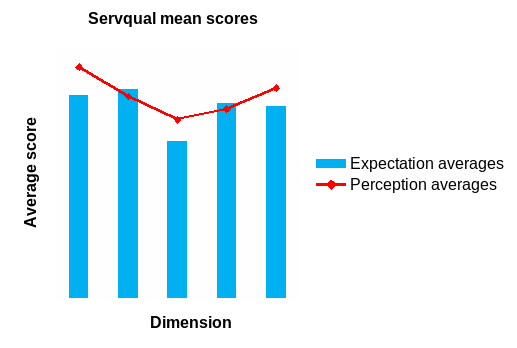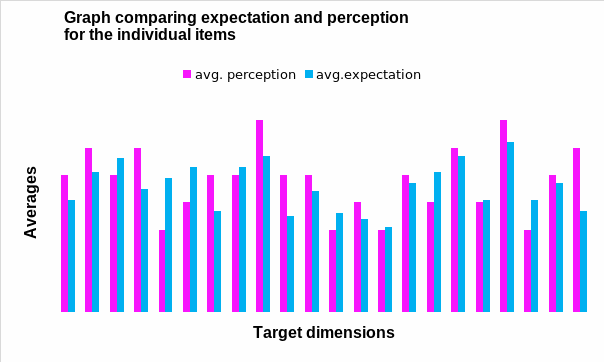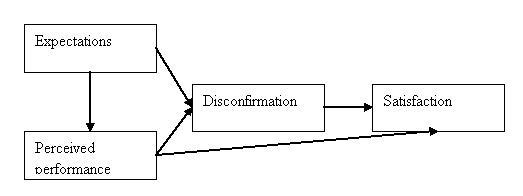Introduction
Services, in most cases, are intangible, thus differentiating service companies from manufacturing companies. When the focus of each is on the customer, as posited by Thomas (2009), they are viewed as service providers, albeit. Of importance is thus a focus on the specific needs of a consumer in order to achieve customer fulfillment. In the quest to deliver services that meet the customers’ needs to fulfillment, the management team of any company must of necessity and continuously assess the quality of these services. Service quality assessment leads to service quality improvement, and as Fraterman (2003) indicates, ‘it involves hard work with a lot of attention to detail and requires passion and consistency of intent’ all through a company’s processes.
Quality management explained
Quality management is an approach that firms employ to understand the exact needs of a customer and consistently to deliver accurate solutions by effectively designing processes that verify the consumer needs and allows for evaluation of performance and the continual improvement of the services, products, and processes that deliver them to the end-users, (Hernon and Altman 2010, pp. 137-141).
SERVQUAL survey
To aid in this process, ‘an important instrument, namely SERVQUAL, has been developed by Parasuraman, Zeithamel and Berry’ (Thomas 2009, p.262). This tool evaluates the two ends of customer expectation versus his/her perceptions. In this assignment, we seek to perform a gap analysis on TNT services using the SERVQUAL survey’s guidelines. This will further help unearth the quality characteristics of the services that need improvement in order to facilitate customer satisfaction.
The management of TNT company ‘administered both the expectations and the perceptions SERVQUAL’ (Thomas 2009, p.262) questionnaire to its customers in order to assess the level of their service delivery and establish areas that need improvement.
Service quality expectations compared with perceptions
‘The averages of each of the dimensions of service quality were computed by averaging the items pertaining to each item and the difference [score] for the dimensions were computed’ (Thomas 2009, p.262) as shown in table 1 and figure 1below. The figures are as generated from the tables in the appendices.
Table 1: Differences between perception and expectation.


Table 2: Individual items averages.
Differences
The analysis shows a positive gap (+0.67) in terms of tangibles perceptions versus expectations (see table 1). This implies that the customer’s expectations are below the TNT’s operational levels. Particularly, it is possible that the TNT Company’s physical facilities and materials associated with service delivery are in good condition and appeal to the customers. Further, the company has invested in quality and modern-looking equipment that persuades the customers’ loyalty. On the contrary, the employees, as viewed by the customer, are not as fascinating in terms of neatness. This could be in terms of their dressing codes, and the general organization may be of items on the shelves or files that could be scattered everywhere.
In respect to the reliability dimension, there is an evident disconnect between customers’ expectations and perceptions. Customers’ prospects are generally higher than the management’s perceptions in three out of the five items constituting reliability. This draws the management’s attention to the items of services related to this dimension to be improved in order to meet the needs of the customers’ expectations. In particular, TNT as a whole needs to endeavor to deliver services timely and honor promises, as well as show a genuine interest in solving the customers’ problems, rather than do so in grumbling or half-heartedly.
For instance, if TNT employees undertake to deliver particular products/services at an agreed time, it is imperative that they honor such. Further, paying attention to customer’s difficulties, it would allow them to improve on the employee-customer relationship and so be able to get hold of the customers’ thoughts on areas that need improvement. This way, the company will win the constancy of its customers as well as widen the customer base.
In terms of responsiveness of employees to the customers, TNT has a favorable record in terms of informing their clients when a particular service will be availed, not being too busy to respond to customer requests and promptness in service delivery. In terms of willingness to help customers, they are below expectations, albeit. This situation could be warranted by the management, not instituting strategies and schemes to motivate the employees’ morale, maybe through salary increments or bonuses to reward good performance.
In regard to assurance, in as much as it’s a plus for the employees in that they have the knowledge to handle customers’ questions, evidently, they don’t exercise courtesy and thus ruin the customers’ confidence in them. There’s a need for the employees to advance courtesy in order to safeguard against customers churning out.
Finally, the positive difference of 0.44 in terms of empathy suggests a close relationship between the employees and the customers in regard to paying close attention to particular needs to specific customers. This is commendable for a company that seeks to retain its customers and hence remain operational, but TN should embank on widening this gap by ensuring they are always above customer expectations
Gap Analysis
This can be viewed as a process through which one identifies discrepancies between the current state of affairs and the desired state and forms the initial stage of service quality improvement. According to Business Dictionary (cited in Richason, 2011), it’s a ‘technique of establishing the necessary steps to move from the current state to the desired state.’ It seeks to mitigate the situation based on a deep knowledge of the underlying conditions that created the current states.
The summary in table 1 above helps the management to understand and assess the gap in the five dimensions of service delivery. Close scrutiny of these gaps sheds light on how best to improve customer satisfaction. The SERVQUAL tool proves very central in achieving this. Thomas (2009, p.259) states that:
“Because services are often intangible, gaps in communication, and understanding between employees and customers have a serious effect on the perceptions of services quality.”
Gap 1 relates to the actual expectations of the customers as compared to what the managers think the customers expect (Thomas, 2009, p.259). There would, for instance, exist a conflict of interest if management paid keenness in improving the company processes at the expense of improving customer service. According to Thomas (2009, p.259), to harness service to customers, we must, in the first instance, understand the customer needs. For instance, the TNT management may perceive the appearance of its equipment as a priority, whereas the client’s focus would be on the durability of the product manufactured from the equipment. Further, it is clear that the management has endeavored to maintain error-free records, which essentially add little if any value to the customer.
A mismatch between the management’s perception and customer specifications of service quality creates gap 2 in the SERVQUAL model. While endeavoring to provide services, employees, and the company at large ought to put into consideration what the customer requirements are in order to align them with the management expectations (Thomas 2009, p.259). The SERVQUAL tool facilitates to identify the particular specifications from a customer’s point of view. For example, TNT service providers must be seen to meet the expectation of being prompt in self-delivery at the time promised, coupled with a sincere heart to solve customer problems.
Lack of proper communication between management and its employees may result in the poor quality of service delivery in terms of how an employee handles a customer. This discrepancy is referred to as gap 3. In the case of TNT services, it was observed in relation to poor employee-customer relations as regards courtesy that would build confidence on the part of the consumer. TNT must thus undertake measures to improve this rather detrimental aspect that could see the company lose customers hence reducing sales. This must be inculcated in each employee in the process of service delivery. They must seek to gain the confidence of consumers as well as be able to accord assurance to customers by ensuring security during a transaction.
Gap 4 results due to unfulfilled promises which a company may relay to its customers and the market at large. The information relayed to customers via media or word of mouth must match the delivery of services in order to bridge this gap. Otherwise, this creates a negative opinion of service quality from the customer. INT has ensured that this gap doesn’t exist by being reliable to its customers.
On the empathy dimension of quality, employees are expected to pay attention to customers at an individual level. This would depict a healthy customer-employee relationship where the client’s interests are attended to whole-heartedly. They aren’t supposed to be always too busy to respond to customer requests.
Overall when the expectations and the perceptions of service quality are not aligned, which is as a result of gaps 1 to 4 being experienced, gap 5 ensues (Thomas 2009, p.262). Employees must make an effort to meet the customers’ expectations and more expeditious exceed these expectations by committing themselves to quality.
Conclusion
TNT Company has a positive trend in terms of tangibles, responsiveness, and empathy. However, it trails back in respect to reliability and assurance. As much as the tangibles are appealing, this state of affairs may snap back in the long run if it doesn’t work on being more reliable to its clients. Further, willingness to respond to customer requests is not an end in itself, but a means to an end, which is to accord the customers assurance in terms of being more courteous in their responses. This is because when consumers are satisfied with the delivery of services, the probability of post-purchase is increased, which further reflects favorably on the number of profits posted. This is well explained in the theory of expectation-confirmation that postulates that if perceived performance outweighs expectation, satisfaction ensues, and post-purchase occurs (Oliver, 1980, p.460).

Assessing service quality should enable TNT management to make viable decisions that are aligned with the customer’s needs.
Reference list
Fraterman, E 2003, Fundamental service quality improvement approaches. Web.
Hernon, P. and Altman, E. 2010. Assessing service quality: satisfying the expectations of library customers. 2nd edition. Web.
Oliver, R.L. 1980. ‘A cognitive model of the antecedents and consequences of satisfaction decisions’, Journal of Marketing Research, vol. 17, no. 3, p. 460. Web.
Richason, O.E. 2011. How do i complete a gap analysis?. Web.
Thomas, S.T. 2009. Managing quality: integrating the supply chain, 4th edition. Upper Saddle River, NJ: Pearson-Prentice Hall. Web.
Appendix A: ServQual Perception Survey
Appendix B: ServQual Expectations Survey

